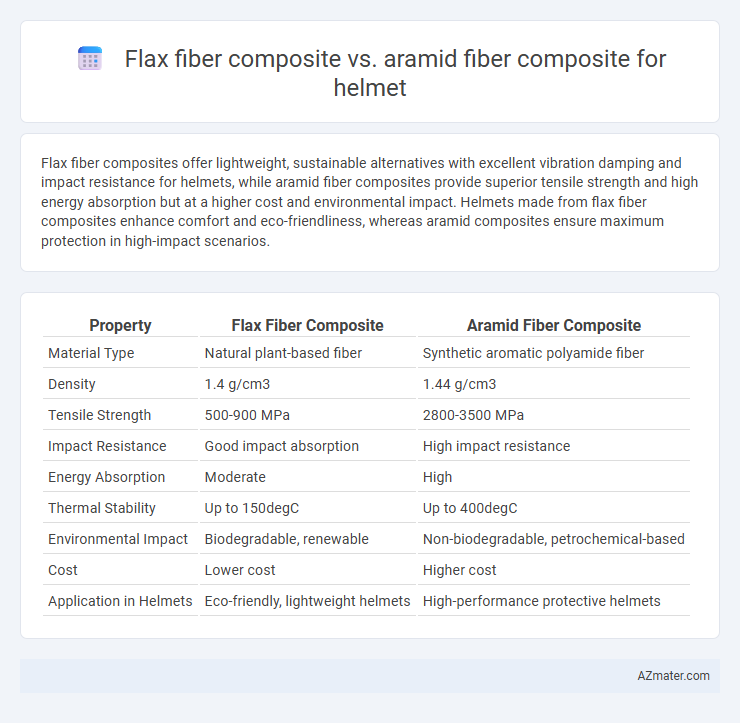Flax fiber composites offer lightweight, sustainable alternatives with excellent vibration damping and impact resistance for helmets, while aramid fiber composites provide superior tensile strength and high energy absorption but at a higher cost and environmental impact. Helmets made from flax fiber composites enhance comfort and eco-friendliness, whereas aramid composites ensure maximum protection in high-impact scenarios.
Table of Comparison
| Property | Flax Fiber Composite | Aramid Fiber Composite |
|---|---|---|
| Material Type | Natural plant-based fiber | Synthetic aromatic polyamide fiber |
| Density | 1.4 g/cm3 | 1.44 g/cm3 |
| Tensile Strength | 500-900 MPa | 2800-3500 MPa |
| Impact Resistance | Good impact absorption | High impact resistance |
| Energy Absorption | Moderate | High |
| Thermal Stability | Up to 150degC | Up to 400degC |
| Environmental Impact | Biodegradable, renewable | Non-biodegradable, petrochemical-based |
| Cost | Lower cost | Higher cost |
| Application in Helmets | Eco-friendly, lightweight helmets | High-performance protective helmets |
Introduction to Helmet Composite Materials
Flax fiber composites offer a sustainable, lightweight alternative to traditional helmet materials, exhibiting high impact resistance and good vibration damping properties essential for protective headgear. Aramid fiber composites, such as Kevlar, provide superior tensile strength and excellent energy absorption, making them a preferred choice for helmets requiring enhanced ballistic and impact protection. The selection between flax and aramid fiber composites depends on balancing environmental benefits, mechanical performance, and specific safety standards in helmet manufacturing.
Overview of Flax Fiber Composites
Flax fiber composites are increasingly favored in helmet manufacturing due to their excellent strength-to-weight ratio, biodegradability, and enhanced impact resistance compared to traditional synthetic fibers. These composites offer superior vibration damping and comfort while maintaining competitive mechanical properties essential for safety standards. Their renewable nature and cost-effectiveness make flax fiber composites a sustainable alternative to aramid fiber composites in protective gear applications.
Overview of Aramid Fiber Composites
Aramid fiber composites, known for their exceptional strength-to-weight ratio and high impact resistance, are widely used in helmet manufacturing for superior protection and durability. These composites exhibit excellent thermal stability and ballistic resistance, making them ideal for military and law enforcement helmets. Compared to flax fiber composites, aramid fibers provide enhanced energy absorption and long-term performance under extreme conditions.
Mechanical Properties Comparison
Flax fiber composites exhibit lower tensile strength and impact resistance compared to aramid fiber composites, making aramid fibers superior for high-performance helmet applications requiring enhanced durability and energy absorption. Aramid fibers like Kevlar offer exceptional tensile strength around 3,620 MPa and excellent abrasion resistance, surpassing flax fibers which typically have tensile strength near 500-1,100 MPa. The stiffness and toughness of aramid composites contribute to better protection against penetration and blunt force, whereas flax composites provide a sustainable, lightweight alternative with moderate mechanical properties.
Weight and Density Analysis
Flax fiber composites exhibit a lower density, typically around 1.4 g/cm3, compared to Aramid fiber composites, which have a density near 1.44 g/cm3, contributing to overall lighter helmet construction. The reduced weight of flax fiber composites enhances wearer comfort and fatigue reduction during prolonged use. Density analysis highlights flax as a sustainable alternative offering comparable ballistic resistance with less mass, optimizing helmet performance through weight efficiency.
Impact Resistance and Safety Performance
Flax fiber composites offer enhanced impact resistance due to their natural energy absorption capabilities, making them a sustainable alternative for helmet construction. Aramid fiber composites, such as Kevlar, provide superior tensile strength and exceptional safety performance by effectively dispersing impact forces and resisting penetration. The combination of flax fiber's shock absorption and aramid's high mechanical strength ensures optimal helmet protection under high-impact conditions.
Environmental Sustainability and Eco-Friendliness
Flax fiber composites offer superior environmental sustainability compared to aramid fiber composites due to their natural origin, biodegradability, and lower carbon footprint during production. Flax fibers are renewable, require less energy to process, and generate less toxic waste, making them eco-friendly materials for helmet manufacturing. In contrast, aramid fibers, such as Kevlar, are synthetic, derived from petrochemicals, and involve energy-intensive production with limited recyclability, resulting in higher environmental impact.
Cost and Manufacturing Considerations
Flax fiber composites offer a cost-effective alternative to aramid fiber composites in helmet manufacturing due to the lower raw material cost and the abundance of flax fibers, reducing overall production expenses. Manufacturing processes for flax fiber composites are less energy-intensive and more environmentally friendly, requiring simpler equipment compared to aramid fibers that demand specialized handling and energy-consuming curing cycles. While aramid fiber composites provide superior impact resistance, the cost benefits and ease of processing make flax fiber composites increasingly attractive for budget-conscious helmet production.
Real-World Applications and Case Studies
Flax fiber composites offer lightweight, eco-friendly alternatives for helmet manufacturing, demonstrating excellent impact absorption in pedestrian and cyclist helmets tested across European safety standards. Aramid fiber composites, such as Kevlar, provide superior tensile strength and durability, making them the preferred choice in military and high-performance sports helmets where ballistic resistance and multi-impact protection are critical. Case studies reveal that hybrid composites combining flax and aramid fibers optimize cost and environmental benefits while meeting stringent safety requirements in real-world applications.
Summary and Future Prospects
Flax fiber composites offer lightweight, sustainable alternatives with good impact resistance and vibration damping for helmets, while aramid fiber composites provide superior tensile strength and proven ballistic protection. Advancements in hybrid composites combining flax and aramid fibers aim to optimize mechanical performance and eco-friendliness. Future prospects emphasize enhancing bio-based resin compatibility, scaling cost-effective production, and improving recyclability to meet evolving safety standards and environmental regulations.

Infographic: Flax fiber composite vs Aramid fiber composite for Helmet
 azmater.com
azmater.com